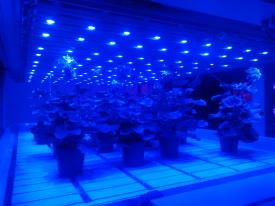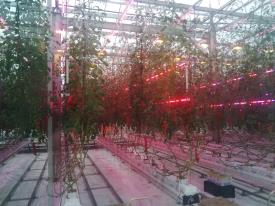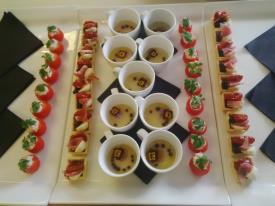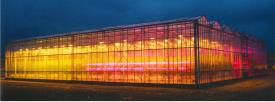In the face of a growing global human population, LED lighting is an exciting technology widely seen as next frontier for horticulture and human sustenance.
Stockbridge's LED4CROPS venture is the type of facility that is leading the way in developing and refining our understanding of LED-lit growing systems. Indeed, it may one day become the blueprint for the next generation of horticultural production.
With sustainability still high on the growth agenda, meeting the needs of future populations will require us to utilise space and energy in the most efficient ways possible. And from the opening presentation by Dr Martin McPherson, it is clear that some of the answers may be found using LEDs.
 The light produced by LEDs wastes less energy as heat, making them more energy-efficient than the sodium bulbs that dominated the 20th Century. This allows growers to develop a multi-layer growing system that maximises the use of space without overloading the room with heat thereby stressing the plants. Without the need for natural light, it is possible to grow plants indoors, allowing for the installation of solar panels on the roof, and the potential for carbon neutrality.
The light produced by LEDs wastes less energy as heat, making them more energy-efficient than the sodium bulbs that dominated the 20th Century. This allows growers to develop a multi-layer growing system that maximises the use of space without overloading the room with heat thereby stressing the plants. Without the need for natural light, it is possible to grow plants indoors, allowing for the installation of solar panels on the roof, and the potential for carbon neutrality.
Furthermore, facilities would no longer be tied to traditional farming locations and could be sited anywhere in the world - even within the hearts of cities.
 One of the pieces of work being carried out at Stockbridge looks into how the use of LEDs allows us to create bespoke 'light recipes' that can optimise the way in which plants grow (impact on plant morphology, pigmentation and flavour). By controlling the spectrum that plants are exposed to, we can maximise the potential of each plant by providing their optimum growing conditions. Year round.
One of the pieces of work being carried out at Stockbridge looks into how the use of LEDs allows us to create bespoke 'light recipes' that can optimise the way in which plants grow (impact on plant morphology, pigmentation and flavour). By controlling the spectrum that plants are exposed to, we can maximise the potential of each plant by providing their optimum growing conditions. Year round.
Officially opened on 10th February by the Rt Hon Michael Jack, CBE, Stockbridge's high wire facilities are currently trialling the effects that different types of light combinations affect the cost of production of Sunstream Tomatoes. The four glasshouse compartments each have a different lighting arrangement:
- Traditional high-pressure sodium (HPS) lighting
- HPS lighting with LED interlighting
- LED top lighting with LED interlighting, and
- LED top lighting, LED interlighting and diffuse glass
 Attendees of the opening event were given a tour of the glasshouse and were able to sample some of the facility's freshly picked tomatoes. Guests were also treated to a range of culinary delights that used Stockbridge's tasty Sunstream tomatoes. The caterers proved that the fruits of Stockbridge's labour deserve the high price that they command in the premium tomato market.
Attendees of the opening event were given a tour of the glasshouse and were able to sample some of the facility's freshly picked tomatoes. Guests were also treated to a range of culinary delights that used Stockbridge's tasty Sunstream tomatoes. The caterers proved that the fruits of Stockbridge's labour deserve the high price that they command in the premium tomato market.
The question was raised on the day whether consumers would accept fresh produce grown in this manner. The idea of buying food that can be grown in Britain year round, the perceivable environmental benefits and the improved energy efficiency of LED systems will likely be an attractive proposition for many. As ever, price will be an important factor, but as our understanding of this technology develops, so too will our ability to be more cost-effective.
So the final hurdle is this. What is it like eating food that is grown under artificial light? The answer is: delicious. I wasn't sure what to expect, but those tomatoes pack a serious punch on flavour, and their scent and texture is top class. Whether they will be accepted by the general consumer remains to be seen. But I would like to hope that people don't turn their back on something new before they've tried it. After all, the truth is in the tasting.
